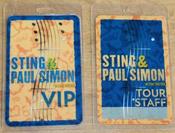
Paul Simon and Sting: On Stage Together
At the Zénith, Simon & Sting (almost) showcase their complicity - the two stars performed together on a third of the thirty songs presented in Paris...
On March 15, singer Art Garfunkel was at La Cigale in Paris, the only French stop on a tour entitled "An Intimate Evening with Art Garfunkel." Around the same time, Paul Simon, the other half of the famous mid-1960s folk-rock duo Simon & Garfunkel, arrived in Berlin. They had split up in 1970 and reformed on a few occasions since. Alongside the name of American Paul Simon on the posters for the European leg of the "On Stage Together" tour, we find that of British singer Sting, former singer and bassist of the equally famous band, The Police, from 1977 to 1983, also reforming in 2007-2008.
A triumph in the United States in February and March 2014, this joint tour by Paul Simon and Sting has been back in action since the end of January, in New Zealand and Australia, and will continue its European tour until April 18 in Amsterdam.
With two evenings at the Zenith in Paris, Friday, April 3 and Saturday, April 4. Where, this Friday, like everywhere else, Simon & Sting offer the audience more than thirty songs (from their bands and their solo careers) and a three-hour concert.
With about fifteen musicians. A wind section, three guitarists (including Simon's regular collaborators Vincent Nguini and Mark Stewart, also a saxophonist, flautist, etc.), two keyboardists (including David Sancious), a violinist, Simon's regular bassist, Bakithi Kumalo, in addition to Sting, two drummers (including Vinnie Colaiuta, hired by Frank Zappa at the age of 22), percussionist Jamey Haddad, a backing singer... Which miraculously manages, with three exceptions, to not overdo it.
Together on stage? Not quite. For four songs at the beginning, four at the encore, including a finale just for the two of them for "When Will I Be Loved?," a superb song by the Everly Brothers. And between each of their respective parts. A first set from Sting, a first from Paul Simon, another for Sting, and another for Simon. With each passing of the baton, there could be an outburst of old friends, of my great friend this, of my wonderful colleague that. Simon & Sting do nothing of the sort. A few smiles, a handshake is enough. Nor do they overplay the recreation of Simon & Garfunkel in their interpretation of Mrs. Robinson, The Boxer, and Bridge Over Troubled Water.
From their own repertoire, each contributes their main hits. As for Sting, it's especially what comes from The Police that hits the mark. So Lonely, When The World Is Running Down… (with a stunning solo from pianist David Sancious), Driven To Tears, Walking On The Moon - and its excessive "hee ho, hee ho" that the audience echoes -, Message In a Bottle, Roxanne - coupled with Ain't No Sunshine, immortalized by Bill Withers -, Every Breath You Take with Simon. The songs from Sting's solo career definitely don't have the same appeal.
Paul Simon, on the other hand, ranges from his solo beginnings, from Mother and Child Reunion (1972), with Sting, to more recent compositions, such as the beautiful Dazzling Blue (2001). His universe is more varied: country-rock, jazz (Still Crazy After all These Years), blues, traveling to different aspects of South African music – in excerpts from his album Graceland (1986) – and that of South America in The Rhythm of the Saints (1990). He even evokes some of the great old songs, the beginnings of rock 'n' roll, with Junior Parker's Mystery Train (1953) or a country classic, Wheels, in honor of guitarist Chet Akins who recorded it in 1963. Artistically, Paul Simon reveals himself to be the most complete through his choices.
(c) Le Monde by Sylvain Siclier




